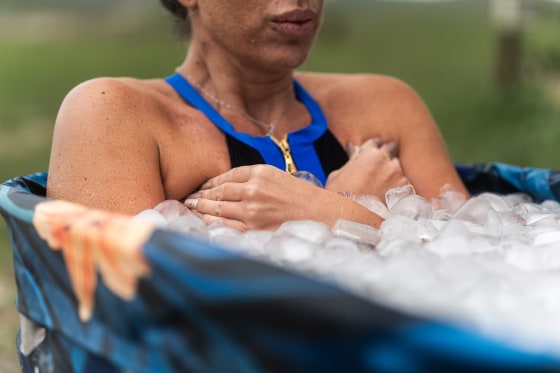
After working out, ice baths are popular, especially with influencers.
A report presented Thursday at the 2024 Integrative Physiology of Exercise Conference in University Park, Pennsylvania, however, indicates that recreational athletes perform better when they soak in a hot tub as opposed to a cold one, particularly if there are breaks in their workouts, like halftime in football and soccer.
The study’s lead author, Mamoru Tsuyuki, a master’s student in sports and health science at Ritsumeikan University in Shiga, Japan, stated that intense exercise damages muscle fibers and that hot water can improve blood flow, allowing the muscles to mend and grow stronger.
Additionally, Tsuyuki told NBC News in a Zoom call that raising muscle temperature would aid increase power output. Heat works best when you have to perform twice in one day, like in halftime sports. If you can submerge yourself in hot water for 15 or 20 minutes, you’ll likely do better in the second half.
According to Tsuyuki, this does not imply that frosty soaks are useless, as additional research has demonstrated that the cold water helps alleviate aching muscles. Furthermore, if there is an injury, ice is ideal.
Tsuyuki expressed his need for additional studies that compare the advantages and downsides of the two temperature soaks.
He stated that while we employed endurance running, the outcomes could alter with various forms of exercise.
Why is a hot soak better?
Ten young guys were selected by Tsuyuki and his colleagues to participate in a three-part study that examined the effects of hot and icy soaks.
After 50 minutes of high-intensity interval running, the men either sat without submersion in water or soaked for 20 minutes in a 59- or 104-degree tub.
Throughout the study, all ten men encountered all three circumstances.
The study participants were instructed to leap as high as they could while standing and squatting an hour following the first session. After a cold bath, the men’s jumping height was lower than after a hot one.
Whether the men soaked in hot or cold water had no effect on how sore their muscles were.
Aimee Layton, an associate professor of applied physiology at Columbia University Vagelos College of Physicians and Surgeons in New York City, stated that ice baths are very popular right now. Additionally, the cold feels excellent when you have an injury that is hot and swollen. You should apply ice to your sprained ankle.
However, Layton noted that cold might be harmful if you are not wounded and have recently had a strenuous workout. She stated that it can stiffen muscles and constrict blood vessels.
According to Layton, intense exercise causes microtears in the muscles. According to her, that’s what signals to your body that you need to build more muscle in that place so that it will be stronger the following time. The recuperation process may be aided by the increased circulation that hot water might provide.
Sports medicine specialist Dr. Spencer Stein, an assistant professor of orthopedic surgery at the NYU Grossman School of Medicine, said the temperature question can be challenging. “I wouldn’t discard cold baths,” Stein remarked. According to some research, taking a cold bath can help reduce pain.
Nevertheless, he claimed that in his experience, professional teams enjoy taking warm showers prior to games. They don’t perform a cold plunge during halftime.
According to David Putrino, director of rehabilitation innovation at the Mount Sinai Health System in New York City, there are several criteria that determine the ideal water temperature for an athlete. Both may affect how blood reaches the muscles.
According to Putrino, hot water enhances blood flow, which might remove waste products linked to physical activity. But for some athletes, cold can increase blood flow by triggering the fight-or-flight reaction.
And that’s where the subtlety comes in.
According to Putrino, the reverse happens if an athlete clenches up and begins to shiver because they detest being thrown into an ice bath. A person can unwind in an ice bath if they don’t mind the cold at all.
According to Putrino, some people enjoy doing cold plunges because they feel invigorated after exiting the water. After they exit, endorphins, the feel-good hormones, flood their bodies, giving them a huge energy boost, he stated.
Using your own data to determine what works for you is what I advise, Putrino stated. Never trust what you hear on podcasts.
Putrino recommends the following for a hot water soak:
- 10 to 20 minutes at 98 to 104 degrees Fahrenheit.
The ideal duration for submersion in ice water is:
- 10 to 15 minutes at temperatures ranging from 50 to 59 degrees.
Five minutes may be helpful for those who are attempting a cold soak for the first time.
Try different temperatures and note which bath helps you recover the fastest, Putrino advised, regardless of your preference for hot or cold water.
Note: Every piece of content is rigorously reviewed by our team of experienced writers and editors to ensure its accuracy. Our writers use credible sources and adhere to strict fact-checking protocols to verify all claims and data before publication. If an error is identified, we promptly correct it and strive for transparency in all updates, feel free to reach out to us via email. We appreciate your trust and support!
